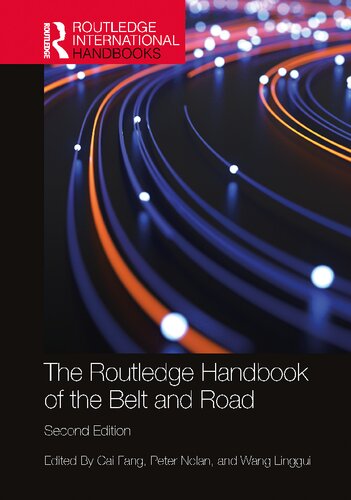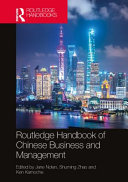Routledge Handbook of the Belt and Road Second Edition by Cai Fang, Peter Nolan, Wang Linggui 1000583449 9781000583441
$50.00 Original price was: $50.00.$25.00Current price is: $25.00.
Routledge Handbook of the Belt and Road Second Edition by Cai Fang, Peter Nolan, Wang Linggui – Ebook PDF Instant Download/Delivery: 1000583449, 9781000583441
Full download Routledge Handbook of the Belt and Road Second Edition after payment

Product details:
ISBN 10: 1000583449
ISBN 13: 9781000583441
Author: Cai Fang, Peter Nolan, Wang Linggui
The second edition of The Routledge Handbook of the Belt and Road encompasses the many recent developments across the Belt and Road Initiative (BRI) from 2019 to 2021, while retaining the comprehensive introduction to BRI from the first edition. The Handbook is a comprehensive review of the theory and practice of the BRI, the contributors to which are leading researchers in their fields. It illuminates the intentions and principles, history and current status, basic knowledge and latest studies, and promotion mechanisms on the whole BRI. This edition includes 132 entries in total, with a supplementary section on the Belt and Road forums for international cooperation, 22 brand new entries, and 13 revised and updated chapters, reflecting current progress. The book provides an authoritative and up-to-date overview of the BRI, and thereupon an explanatory interpretation of China’s development strategy and international policy stance. Already serving as the essential “encyclopaedia” of the BRI, this second edition will be a must-read for members of global think tanks, policy makers, and observers involved in the BRI□ construction, as well as researchers interested in international relations, Chinese economics, politics, and international policy.
Routledge Handbook of the Belt and Road Second Table of contents:
Part I Contribution of China’s Reform and Opening-Up to the World and Formation of the Belt and Road Initiative
1 The Historic Contribution of China’s Reform and Opening-Up to the World
The Development Process of China’s Reform and Opening-Up
The Historic Contribution of China’s Reform and Opening-Up
Notes
2 Developing an Open Economy and the Belt and Road
The Formation and Development of an Open Economy
Achievements and Prospects of Building an Open Economy
The Belt and Road Initiative Promotes the Development of an Open Economy
Notes
3 China’s Economic Restructuring and the Belt and Road
Characteristics and Process of China’s Economic Restructuring
The Path and Effectiveness of China’s Economic Restructuring
China’s Economic Restructuring and the Belt and Road Complement Each Other
Notes
4 Innovation-Driven Development and the Belt and Road
Concepts and Features of Innovation-Driven Development
Path and Achievements in Innovation-Driven Development
Innovation-Driven Development Leads the Building of the Belt and Road
Notes
5 Responsibilities of China as a Major Country and the Belt and Road
Principles and Position of Responsibilities and Accountabilities of China as a Major Country
Fields and Contributions of Responsibilities and Obligations of China as a Major Country
Responsibilities and Obligations of China for the Belt and Road
Notes
6 Confidence of a Major Country and the Belt and Road
From the “Three Aspects of Confidence” to “Four Aspects of Confidence”
The Confidence of a Major Country Must be Based on Confidence in Culture
The Belt and Road Highlights the Confidence of China as a Major Country
Notes
7 Deficit in Development and the Belt and Road
Notes
8 Deficit in Peace and the Belt and Road
Elaboration on the Concept of “Deficit in Peace” and Development
China’s New Contributions to the World in Response to a Deficit in Peace
The Significance of Coping with a Deficit in Peace Through the Belt and Road Initiative
Note
9 Deficit in Governance and the Belt and Road
The Meaning and Presentation of a Global Deficit in Governance
The Wisdom of China and Chinese Concept for the International Order
The Belt and Road Initiative Makes Up for Deficit in Global Governance
Notes
10 Development Course of the Belt and Road Initiative: Progress and Challenges
Major Progress Made in Building the Belt and Road
Major Challenges in the Belt and Road Construction
Notes
Part II Historic Inheritance
11 Naming of the Silk Road
Notes
12 A Brief History of the Silk Road
The Prehistory of the Silk Road
Zhang Qian’s Journey to the Western Regions and the Silk Road
The Prosperity of the Silk Road During the Sui and Tang Dynasties
The Decline and Rejuvenation of the Silk Road
Notes
13 The Overland Silk Road
The Basic Trend of the Desert Silk Road
The Steppe Silk Road
The Southern Silk Road
The Historical Significance of the Overland Silk Road
Notes
14 The Maritime Silk Road
The Eastern Maritime Silk Road
The Southern Maritime Silk Road
The Sea Ban and the Decline of the Dominant Power of the Maritime Silk Road
Notes
15 Silk Road and Exchanges Among Different Countries
Commodity Exchanges on the Silk Road
Frequent Flow of People on the Silk Road
Notes
16 The Silk Road Spirit
What is the Silk Road Spirit?
The Content of the Silk Road Spirit
How to Promote the Silk Road Spirit
Notes
Part III Formation and Framework of the Concept
17 Process for Proposing the Concept
President Xi Jinping Took the Lead in Issuing the Initiative
Promulgation of the “Vision and Actions”
Continual Evolvement of the Ideas of the Belt and Road
Notes
18 Background
Global Background of Building the Belt and Road
Regional Background of Building the Belt and Road
Domestic Background of Building the Belt and Road
Some Misunderstandings About the Belt and Road Initiative
Notes
19 The Belt and Road Initiative Framework
Upholding Four Concepts and Building Three Communities
Building Four Major Silk Roads
Upholding the Principles of Extensive Consultation, Joint Contribution, and Shared Benefits
Five Key Cooperation Directions
A Framework Including Six Corridors, Six Means of Communication, Multiple Countries, and Multiple Ports
The “Five Types of Connectivity”
Cooperation Mechanisms
Organisational Guarantee of the Belt and Road
Promoting the Formation of a New Pattern of Regional Economic Integration
Notes
20 Basic Contents
The Basic Content of the Silk Road Economic Belt
The Basic Content of the 21st Century Maritime Silk Road
The Basic Content of the Belt and Road
Notes
21 Principles of Extensive Consultation, Joint Contribution, and Shared Benefits
Proposal of the Principles of Extensive Consultation, Joint Contribution, and Shared Benefits
The Content and Internal Logic of the Principles of Extensive Consultation, Joint Contribution, and Shared Benefits
Theoretical and Practical Significance of the Principles of Extensive Consultation, Joint Contribution, and Shared Benefits
Upholding the Principles of Extensive Consultation, Joint Contribution, and Shared Benefits
Note
22 Partners
Categories of Partners of the Belt and Road Initiative
International Relation Actors
Principal Status
Development Level
Geographical Coverage
Paths to Participate in the Belt and Road
Partners whose Strategies are Aligned with the Belt and Road Initiative or Partners with Cooperation Intention
Sovereign Countries
Northeast Asian Countries
Southeast Asian Countries
South Asian Countries
Central Asian Countries
Middle East Countries
European Countries
African Countries
Latin American and Caribbean Countries
Oceanian Countries
International Organisations
Non-Governmental Organisations (NGOs)
Notes
23 General Ideas
Basic Positioning and Main Purposes of the Belt and Road
The Ultimate Goal of the Belt and Road
Note
24 Directions of Cooperation
Specific Contents of Cooperation
Background for Proposing the Cooperation Directions
The Role of Cooperation Direction in the Belt and Road
External Influence of Cooperation Directions
Notes
25 Cooperation Mechanisms
Top-Level Cooperation Mechanisms
Synergy with Other Development Strategies
Multilateral Cooperation Mechanisms
Bilateral Cooperation Mechanisms
Notes
26 Organisational Structure
Content and Basic Organisational Structure
Position of the Organisational Structure in the Strategic Decisions of the Central Government and its Tasks
Innovative Working Mechanism and Concept of the Leading Group in the New Stage of Deepening Reform and Opening-Up
Notes
27 General Framework
Proposal of the Concept
Main Achievements
Note
28 Detailed Blueprint
Proposal and Connotation of the Idea
Key Points of the Detailed Blueprint
Note
Part IV The Five Roads
29 The Belt and Road Initiative and the Road of Peace
Concept and Origin of the Road of Peace
Spirit of the Road of Peace Reflected in the Belt and Road Initiative
Contribution of the Road of Peace to the World
Notes
30 The Belt and Road Initiative and the Road of Prosperity
Concept and Origin of the Road of Prosperity
Spirit of the Road of Prosperity Reflected in the Belt and Road Initiative
Contribution of the Road of Prosperity to the World
Notes
31 The Belt and Road Initiative and the Road of Openness
Concept and Origin of the Road of Openness
Spirit of the Road of Openness Reflected in the Belt and Road Initiative
Contribution of the Road of Openness to the World
Notes
32 The Belt and Road Initiative and the Road of Innovation
Concept and Origin of the Road of Innovation
Spirit of the Road of Innovation Reflected in the Belt and Road Initiative
Contribution of the Road of Innovation to the World
Notes
33 The Belt and Road Initiative and the Road Connecting Different Civilizations
Concept and Origin of the Road Connecting Different Civilizations
Spirit of the Road Connecting Different Civilizations Reflected in the Belt and Road Initiative
Contribution of the Road Connecting Different Civilizations to the World
Notes
Part V Five Types of Connectivity
34 Policy Coordination
The Concept of Policy Coordination
Practical Significance of Policy Coordination
Implementation Progress of Policy Coordination
35 Facilities Connectivity
The Concept of Facilities Connectivity1
Practical Significance of Facilities Connectivity
Implementation Progress of Facilities Connectivity
Notes
36 Unimpeded Trade
The Concept of Unimpeded Trade
Practical Significance of Unimpeded Trade
Implementation Progress of Unimpeded Trade3
Notes
37 Financial Integration
The Concept of Financial Integration
Practical Significance of Financial Integration
Implementation Progress of Financial Integration
38 People-to-People Bonds
The Concept of People-to-People Bonds
Practical Significance of People-to-People Bonds
Implementation Progress of People-to-People Bonds
Cultural and Academic Exchanges
Tourism Cooperation and Sports Exchanges
Disease Control and Medical Cooperation
Language Cooperation and Talent Training
Double-Track Exchange Between Political Parties and Think Tanks
People-to-People Exchange and Media Cooperation
Part VI The Six Economic Corridors
39 China–Mongolia–Russia Economic Corridor
Concept of the China–Mongolia–Russia Economic Corridor
Details of the China–Mongolia–Russia Economic Corridor
Implementation Developments of the China–Mongolia–Russia Economic Corridor
Notes
40 The New Eurasian Continental Bridge Economic Corridor
Concept of the New Eurasian Continental Bridge Economic Corridor
Details of the New Eurasian Continental Bridge Economic Corridor
Implementation Developments of the New Eurasian Continental Bridge Economic Corridor
Notes
41 The China–Central Asia–West Asia Economic Corridor
Concept of the China–Central Asia–West Asia Economic Corridor
Details of the China–Central Asia–West Asia Economic Corridor
Implementation Developments of the China–Central Asia– West Asia Economic Corridor
Notes
42 The China–Indochina Peninsula Economic Corridor
Concept of the China–Indochina Peninsula Economic Corridor
Details of the China–Indochina Peninsula Economic Corridor
Implementation Developments of the China–Indochina Peninsula Economic Corridor
Notes
43 The China–Pakistan Economic Corridor
Concept of the China–Pakistan Economic Corridor
Details of the China–Pakistan Economic Corridor
Implementation Developments of the China–Pakistan Economic Corridor
Notes
44 The Bangladesh–China–India–Myanmar Economic Corridor
Concept of the BCIM Economic Corridor
Details of the BCIM Economic Corridor
Implementation Developments of the BCIM Economic Corridor
Notes
Part VII Theories and Concepts of Foreign Affairs with Chinese Characteristics
45 Major-Country Diplomacy with Chinese Characteristics
The Formation of the Concept of Major-Country Diplomacy with Chinese Characteristics
The Main Content of the Major-Country Diplomacy with Chinese Characteristics
The Practical and Theoretical Significance of Major-Country Diplomacy with Chinese Characteristics
Notes
46 New-Type International Relations
The Formation of the New-Type International Relations
The Main Content of the New-Type International Relations
The Practical Significance of the New-Type International Relations
Notes
47 New-Type Major-Country Relations
The Formation of the Concept
The Main Content of New-Type Major-Country Relations
Realistic and Theoretical Significance of New-Type Major-Country Relations
Notes
48 The Community with a Shared Future for Mankind
Elaboration and Formation of the Concept
Main Content of the Community with a Shared Future for Mankind
Theoretical and Practical Significance of the Concept
Notes
49 Two Centenary Goals
Proposal and Definition of the Two Centenary Goals
Theoretical and Practical Significance of the Two Centenary Goals
Notes
50 Win–Win Cooperation
The Proposal of Win–Win Cooperation
The Connotation of Win–Win Cooperation
The Practical Significance of Win–Win Cooperation
Notes
People also search for Routledge Handbook of the Belt and Road Second :
routledge handbook on jerusalem
routledge handbook
routledge handbook of public diplomacy
routledge handbook of peacebuilding and ethnic conflict
Tags:
Cai Fang,Peter Nolan,Wang Linggui,Routledge Handbook
You may also like…
Uncategorized
Uncategorized
Linguistics - Linguistics
Linguistics - Sociolinguistics
The Routledge Handbook of Discourse Analysis Second Edition Michael Handford
Politics & Philosophy - Cultural
The Routledge International Handbook of Mad Studies 1st Edition Peter Beresford (Editor)
Politics & Philosophy - International Relations
China s Belt and Road Vision Geoeconomics and Geopolitics S Mahmud Ali
Engineering - Civil & Structural Engineering
Critical Landscape Planning During the Belt and Road Initiative 1st Edition Ashley Scott Kelly
Linguistics - Linguistics
The Routledge Handbook of Stylistics Second Edition by Michael Burke 9780367567491 0367567490
Business & Economics - Management & Leadership










